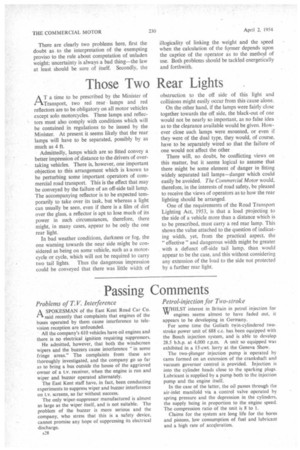Passing Comments
Page 30

Page 31

If you've noticed an error in this article please click here to report it so we can fix it.
Problems of T. V. Interference
A SPOKESMAN of the East Kent Road Car Co. 4-1. said recently that complaints that engines of the buses operated by them cause interference to television reception are unfounded.
All the company's 610 vehicles have oil engines and there is no electrical ignition requiring suppressors.
He admitted, however, that both the windscreen wipers and the buzzers cause interference "in some fringe areas." The complaints from these are thoroughly investigated, and the company go so far as to bring a bus outside the house of the aggrieved owner of a t.v. receiver, when the engine is run and wiper and buzzer operated alternately.
The East Kent staff have, in fact, been conducting experiments to suppress wiper and buzzer interference on t.v. screens, so far without success.
The only wiper-suppressor manufactured is almost as large as the wiper itself, and is not suitable. The problem of the buzzer is more serious and the company, who stress that this is a safety device, cannot promise any hope of suppressing its electrical discharge.
s28
Petrol-injection for Two-stroke
WHILST interest in Britain in petrol injection for " engines seems almost to have faded out, it appears to be developing in Germany.
For some time the Goliath twin-cylindered twostroke power unit of 688 c.c. has been equipped with the Bosch injection system, and is able to develop 28.5 b.h.p. at 4,000 r.p.m. A unit so equipped was exhibited in a 15-cwt. lorry at the Geneva Show.
The two-plunger injection pump is operated by cams formed on an extension of the crankshaft and vacuum governor control is provided. Injection is into the cylinder heads close to the sparking plugs. Lubricant is supplied by a pump both to the injection pump and the engine itself.
In the case of the latter, the oil passes through the air-inlet manifold via a control valve operated by spring pressure and the depression in the cylinders, the supply being in proportion to the engine speed. The compression ratio of the unit is 8 to 1.
Claims for the system are long life for the bores and pistons, low consumption of fuel and lubricant and a high rate of acceleration.
With a Land-Rover in Argentina
MEWS comes from R. K. Hubbard who, many " years ago, was secretary of the Mechanical Transport Committee at the War Office. During his 16 years' military service and even before 1913, when the late George Watson was technical editor, he was a reader of The Commercial Motor. When he went to Argentina in 1930 to become an executive of the British Argentine Railways, he continued to receive it, but he retired in 1948, as the railways were taken over by the government of that country.
He remained there and is now the proud possessor of a Land-Rover which, he says, was the only Britishbuilt vehicle he could buy new and it has turned out most suitable for the long journeys, often over unmade roads, which he makes. He has fitted out this go-anywhere model for, as he says, "sleeping, eating and drinking."
His principal journeys are from Buenos Aires to the Parana River, where he goes dorado fishing, this species being as good as salmon. The mileage is about 700 each way. When Buenos Aires gets too hot in December or January, he travels to the Andes —a thousand miles away—for trout and salmon fish
ing. Most of the journey is over rough gravel roads, with stretches of soft sand and rnudholes in different parts, and he usually limits himself to 300 miles a day. He states that he observed with interest the founding of the Institute of Road Transport Engineers, which he considers was an excellent move.
In April, Mr. Hubbard is returning to London for a few months and hopes to meet some of his old friends.
Where Our Gravel Went
TT is an old joke that the capital of England is in 'America, but this is almost literal fact. Speaking at the annual dinner of the Ballast, Sand and Allied Trades Association recently, Sir Herbert Williams, M.P., said that one-third of the city of New York once lay at the bottom of the Thames.
Gravel from the bed of the Thames travelled across the Atlantic as ballast for sailing ships and was dumped on arrival. Later, it was used in the concrete with which New York was built.
What a rumpus there would be if the London County Council claimed it back!








































































































